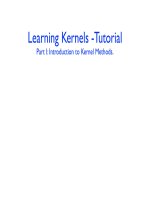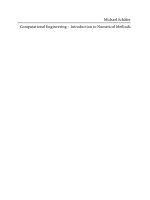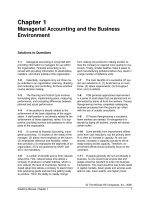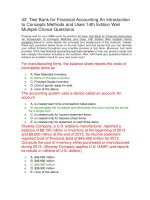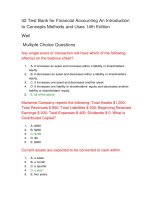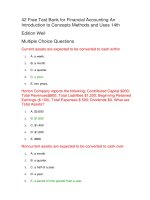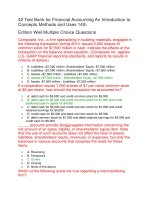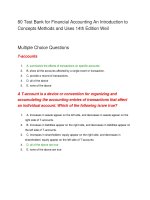Managerial accounting and introduction to concepts methods and user 11e by maher chapter 03
Bạn đang xem bản rút gọn của tài liệu. Xem và tải ngay bản đầy đủ của tài liệu tại đây (318.65 KB, 28 trang )
CHAPTER 3
Activity-Based
Management
PowerPoint Presentation by
LuAnn Bean
Professor of Accounting
Florida Institute of Technology
© 2012 Cengage Learning. All Rights Reserved. May
not be copied, scanned, or duplicated, in whole or in
part, except for use as permitted in a license
distributed with a certain product or service or
otherwise on a password-protected website for
classroom use.
Managerial Accounting 11E
Maher/Stickney/Weil
1
☼
CHAPTER GOAL
☼
This chapter shows how ABC and ABM rest on
the premise that: Products require activities
and activities consume resources. For
products to be competitive, managers must
know
Activities for producing goods, services
Cost of activities
ABC analyses ways to allocate indirect costs
while ABM uses analysis to manage costs.
2
LO 1
How do ABC and
ABM work?
ABC provides information about
profitability in mix of activities,
products
ABM encourages managers to use
information to become low-cost
producer or seller.
3
LO 1
ABM ACTIVITY ANALYSIS
Chart, start to finish, activities used to
complete product or service
Classify activities as value-added or nonvalue-added
Eliminate non-value-added activities
Continuously improve, reevaluate efficiency
of value-added activities or replace with more
efficient activities
4
LO 1
Value Chain
Organization Strategy and Administration
Production Marketing Distribution Customer
Service
Customer
EXHIBIT 3.1
Research and Design
Development
5
LO 1
Value Chain
Organization Strategy and Administration
Research and Design
Development
Production Marketing Distribution Customer
Service
ABM
ABManalyses
analysesand
and
evaluates
evaluatesevery
every
step
stepof
ofthe
theValue
Value
Chain.
Chain.
EXHIBIT 3.1 & 3.2
Customer
6
LO 1
NON-VALUE-ADDED
NON-VALUE-ADDED COSTS:
COSTS:
Definition
Definition
Are costs of activities that the company
can eliminate without reducing product
quality, performance, or value.
7
LO 1
Value Chain
Organization Strategy and Administration
Research and Design
Development
Production Marketing Distribution Customer
Service
ABM
ABManalyses
analysesand
and
evaluates
evaluatesevery
every
step
stepof
ofthe
theValue
Value
Chain.
Chain.
Eliminate
EXHIBIT 3.1 & 3.2
Customer
8
LO 1
ABC ANALYSIS
Potential candidates for elimination because they
do not add value are
Storage
Moving: parts, materials, etc. around the factory
floor
Idle time
Other production process components
9
LO 2
EXAMPLE
You and a friend go to dinner. You order tea ($2.50) and
a salad ($8.00). Your friend orders appetizer,
expensive entree, and dessert. The total bill is $60.
Traditional cost allocation leads to splitting the bill,
$30 apiece.
What does activity analysis suggest each of you
should pay?
YOU: $ 10.50 + tax & tip
FRIEND: $49.50 + tax & tip
10
LO 2
ABC COST-BENEFIT
Applying ABC has a cost of information gathering.
Managers must take cost-benefit into account.
Managers reject activity analysis, staying with traditional
methods that are simpler.
Smaller companies don’t need sophisticated information systems
Managers use ABC because information helps them be
competitive
Complex organizations facing heavy competition use ABC
Managers use ABC in special circumstances
11
LO 2
COST POOLS
Three major types of cost pools:
The “plant” (traditional)
Sets one indirect cost allocation rate plantwide
The department (traditional)
Sets indirect cost allocation rates for each department
The activity center (ABC)
Determines cost pool for each activity
12
LO 4
ABC STEPS TO FOLLOW
Accountants required to follow four steps:
1. Identify activities that consume resources; assign
costs to those activities.
Example: purchasing materials
1. Identify cost drivers for each activity.
Cost driver for purchasing materials: # of orders
1. Compute a cost rate per cost driver unit.
Cost per order
1. Assign costs to products.
(Cost per order) X (number of purchase orders)
13
LO 4
COST
COST DRIVER:
DRIVER: Definition
Definition
Is a factor that causes,
“drives,” an activity’s
costs.
14
LO 4
Which cost drivers listed below would a law firm use?
Machine hours
Number of surgeries
Computer time
Purchase orders
Labor hours, cost
Scrap/rework orders
Items produced, sold
Quality inspections
Pounds of material handled
Hours of testing time
Clients served
# of parts in product
Pages typed
# of different clients
Flight hours
Miles driven
Machine setups
EXHIBIT 3.3
EXAMPLE: Cost Drivers
15
LO 4
Which cost drivers listed below would a law firm use?
Machine hours
Number of surgeries
Computer time
Purchase orders
Labor hours, cost
Scrap/rework orders
Items produced, sold
Quality inspections
Pounds of material handled
Hours of testing time
Clients served
# of parts in product
Pages typed
# of different clients
Flight hours
Miles driven
Machine setups
EXHIBIT 3.3
EXAMPLE: Cost Drivers
16
LO 4
How do managers decide
which cost driver to use?
Typically, managers choose a
cost driver that causes the
cost.
17
LO 4
COST RATE EQUATION
Predetermined indirect cost rate =
Estimated Indirect Cost
÷
Estimated Volume of Allocation Base
18
LO 4
EXAMPLE: Traditional Costing
Ciudad Juarez factory makes 2 products: mountain bikes and
racing bikes. 1,000 mountain bikes and 200 racing bikes will be
produced. Direct materials include
Frames: $100 per mountain bikes and $200 per racing bike
Direct labor: $30 per mountain bike and $60 per racing bike
Overhead, allocated at 5 times direct labor
What would be the cost of each bike under traditional
costing?
Continued
19
LO 4
EXAMPLE: Traditional Costing
Mountain Bikes Racing Bikes
Direct materials
Direct Labor
Manufacturing overhead1,2
Total cost per bike
1
5 * DL
2
($150 * 1,000 + $300 * 200) = $210,000
$100
$200
30
150
60
300
$280
$560
Continued
20
LO 4
EXAMPLE: ABC Costing
Ciudad Juarez factory makes 2 products: mountain bikes and
racing bikes. 1,000 mountain bikes and 200 racing bikes will be
produced. Direct materials include
Frames: $100 per mountain bikes and $200 per racing bike
Direct labor: $30 per mountain bike and $60 per racing bike
Overhead, allocated by activity costs
What would be the cost of each bike under ABC
costing?
Continued
21
LO 4
EXAMPLE: ABC Costing
Activity
Rate
Mountain Bike
Racing Bike
Cost driver
units
Cost driver
units
Purchasing $20/frame
1,000 frames
Setups
Cost
Allocated
Cost
Allocated
$ 20,000 1,000 frames
$ 4,000
13 setups
26,000 13 setups
60,000
Inspections $100/inspect hr 200 hours
20,000 200 hours
20,000
Running
machines
45,000 1,500 hrs
15,000
$2,000/setup
$30/hour
1,500 hrs
Total
$111,000
$99,000
Mountain Bike = $111,000 / 1,000 = $111
Racing Bike = $99,000 / 200 = $495
EXHIBIT 3.5
22
LO 6
COST
COST HIERARCHY:
HIERARCHY: Definition
Definition
Categorizes costs so
changes in one cost can be
examined for its effects on
other cost categories.
23
LO 6
EXAMPLE: Hierarchy of Costs
Activity Category
Example
Capacity
Size limitations
Aircraft depreciation
Customer
Needs
Special promotions
Product
Production needs
Route schedules
Batch
Batch
Fuel, baggage handling
Unit
Variable costs
Credit card fees
24
LO 7
RESOURCES
RESOURCES USED:
USED: Definition
Definition
Are measured by
ABC.
25
